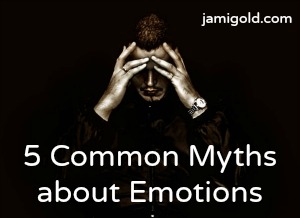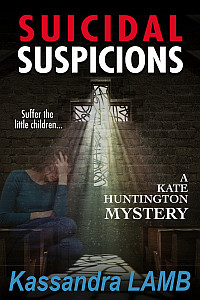We all have emotions, so we all think we know how to write them. However, one of those emotions we’ve probably all experienced is denial, and that means we might be in denial about some truths for how emotions really work.
Yet sometimes the best writing—the writing that will hit hardest and feel deepest and truest to readers—comes from exposing an emotional truth that we’ve hidden from ourselves. When that happens, the story helps readers feel like they understand themselves better too.
(As readers, if we’ve experienced that emotional “gut check” in a story, we know how powerful that can feel.)
So if we have a better understanding of emotions, we might have a better chance of exploring some of those emotional truths that can resonate with our readers.
Today I’m thrilled to welcome back Kassandra Lamb, as she shares a few common misconceptions about how emotions work and gives us ideas for how we can incorporate the truth in our stories. Please welcome Kassandra Lamb! *smile*
*****
5 Common Misconceptions about Emotions
(That We Can Use as Authors)
Homo sapiens have been sentient beings for thousands of years, and still we do not truly understand our own emotions. Yet we are fascinated by them.
Because, like it or not, emotions rule our lives. We all strive for happiness, and feel an array of emotions—anger, fear, sadness—when life thwarts those efforts.
Why do readers read? Some read solely to escape the emotional roller coaster of real life, but others seek to absorb themselves in the emotional lives of the characters so that they can better understand and live their own lives.
By understanding the misconceptions about emotions that we humans tend to believe out of ignorance or cling to out of denial, we can write better stories. By challenging these misconceptions and digging a little deeper into the human emotional experience, we can write enlightening and inspiring stories!
Myth #1: Good and Bad Emotions Should Be Mutually Exclusive
This might fall more in the category of wishful thinking than true belief. We know that we sometimes have mixed emotions about things. But it happens more frequently than we like to acknowledge.
Often, we’re not in touch with our conflicting feelings. We may ignore the negative emotions, because, after all, happy feels better than angry or sad. Or if we’ve harbored a longstanding anger toward someone, we may resist acknowledging positive emotions toward them. Indeed, those positive feelings may unconsciously fuel our anger.
Great fodder for internal conflicts in our characters’ development.
How many stories begin with a main character embarking on a new chapter in their lives? They’re excited about the future, but also anxious, maybe even downright terrified.
How much more realistic and poignant that character will be if s/he also experiences some grief for the past left behind? (And a good place to throw in an intriguing hint about their back story.)
Myth #2: If You Ignore an Emotion, It Will Go Away
Only if it’s a very mild emotion. Minor irritations or fleeting empathy for someone else’s grief, yeah, those will evaporate readily. But more intense reactions, not so much.
Emotions have an energy about them. They need to be acknowledged and vented in order to dissipate (I’ve talked more about this on my blog).
Emotions that aren’t sufficiently acknowledged and expressed tend to go underground. They may turn into depression or malcontent and come out indirectly as spurts of irrational anger or grief, snide remarks, or simmering resentments.
All too often they’re directed at people other than those who caused the emotions in the first place. The psychobabble term for this is transference.
So resentment toward an ex-wife may come out as anger toward women in general. But that’s so obvious. What is less so is the self-absorbed mother who frequently asked her young son if he loved her, and later that son is unable to say those words to the woman he adores.
Which brings us to…
Myth #3: True Love Cures Emotional Problems
Yeah, if this were true we would have no dysfunctional families and the divorce rate would be 2%. Emotional issues almost always have very deep roots–some biological, others psychological. Being loved does not make these factors magically disappear.
But people often believe that they will. If I just love him enough, he’ll stop gambling, be more affectionate, stop obsessing about germs on doorknobs, etc.
Some people also tend to believe that being loved will magically turn them into saner beings, cured of past hurts and somehow emotionally whole again. If I just find my one true love, all will be fine in my life.
As a psychologist, it makes me grind my teeth when I see this myth perpetuated in fiction.
As authors, we want to have flawed, realistic characters who have room to change and grow during the story, but having them fall in love is not enough to bring about that growth.
However, feeling truly loved, perhaps for the first time in one’s life, can provide both the motivation and some of the necessary resources to dig out emotional problems by the roots.
The hard work still needs to be done though, and first the character has to realize that they have to work at it. Showing our characters struggling with this process—inspired by the love of their life but nonetheless sliding back into old patterns–this will make them believable, relatable and perhaps even inspiring.
And here is another opportunity for some good plot twists. Is their lover willing and able to ride the roller coaster with them as they struggle to become a better person?
I had more than one client, when I was a practicing therapist, who started out their healing journey in what they thought was a loving and supportive relationship, only to have that relationship become unraveled as they improved their mental health…and outgrew their partner.
Myth #4 Being Emotional Is a Sign of Weakness
In reality, these two traits, emotional sensitivity and emotional strength, are only partially related. I’ve known plenty of sensitive people who were pretty darn strong, and some weak people who were quite emotionally shallow.
The relationship between these traits comes into play when people have to deal with adversity. Will a sensitive person discover strengths they didn’t think they had, or will they be crushed? Will a strong person fall apart when long-buried emotions are stirred up?
As a novice writer, I made the mistake of making my main characters much too together psychologically. I hadn’t left them a whole lot of room to grow during the course of my mystery series.
But then I remembered that even “together” people can fall apart when life throws them a curve ball. I’ve gotten really good at lobbing curve balls at my characters. 😀
However, if we try to bust this myth in our stories, we need to do so with care. This is a belief that readers often cling to with great resistance.
In Book 3 in my series, I decided to see how much crap I had to throw at my heroine before she would break. Some of my beta readers complained that Kate cried too much in this book, and that “made her look weak.”
I did tone down the crying some—even though I was thinking: Oh come on! She’s grieving her husband, someone is threatening her baby, she’s being sued for malpractice and she’s a murder suspect!
Personally, I would be crying buckets in her shoes. See what I mean about people resisting giving up this belief?
I took the risk anyway and brought my MC to the edge of a breakdown (with a few less tears). I wanted to make two points: that even strong people have their limits and that strength is less about endurance and more about one’s ability to put the pieces back together after you’ve fallen apart.
In Book 4, I went after her husband with the same agenda. Which brings us to…
Myth #5 Men Are Less Emotional than Women
Nope! Psychological research studies have found that men and women feel the same feelings at about the same level of intensity in the same situations.
The differences come out in when and how the emotions are expressed, and these differences are learned. They are not innate. (For more on this, see my post here.)
This is important to keep in mind when using deep POV. The internal visceral sensations will be similar, as will some, but not all, of the inner dialogue.
The woman may think, Oh my! when a friend bursts into tears; a man is more likely to think, Aw sh*t! But both will have aching throats and stinging eyes.
The woman may let her own tears flow in empathy as she wraps her arms around the friend. The man is more likely to swallow hard, blink away the grittiness and pat the friend on the shoulder.
I got some flak from beta readers on Book 4, because they felt my male protagonist was too emotional. I did tone down his external behaviors some before releasing the final version, but mostly I just kept saying, “But that’s the whole point. That’s what the story’s exploring—what kinds of challenges and threats can bring a strong man to his knees?”
Confronting any of these misconceptions is not without risk. The reader looking for escapism may close your book without finishing it.
But challenging these beliefs about feelings can make a story resonates on a deeper emotional level, when readers have that aha moment, “Yes, that really is how that feels.”
Please check out my new release. In this one, I throw the meanest curve ball yet at my heroine…
*****
 Writing and psychology have always vied for number one on Kassandra Lamb’s Greatest Passions list. In her youth, she had to make a decision between writing and paying the bills. Partial to electricity and food, she studied psychology. Now retired from a career as a psychotherapist and college professor, she spends most of her time in an alternate universe with her characters. The portal to this universe (aka her computer) is located in Florida where her husband and dog get occasional glimpses of her. She and her husband also spend part of each summer in her native Maryland, where the Kate Huntington mysteries are set.
Writing and psychology have always vied for number one on Kassandra Lamb’s Greatest Passions list. In her youth, she had to make a decision between writing and paying the bills. Partial to electricity and food, she studied psychology. Now retired from a career as a psychotherapist and college professor, she spends most of her time in an alternate universe with her characters. The portal to this universe (aka her computer) is located in Florida where her husband and dog get occasional glimpses of her. She and her husband also spend part of each summer in her native Maryland, where the Kate Huntington mysteries are set.
Find Kass on Twitter and Facebook, sign up for updates on Kate’s World at Kass’s website, and check out her posts on psychological topics and other random things at the misterio press site.
*****
About SUICIDAL SUSPICIONS, A Kate Huntington Mystery, #8:
Psychotherapist Kate Huntington is rocked to the core when one of her clients commits suicide. How can this be? The woman, who suffered from bipolar disorder, had been swinging toward a manic state. The client’s family is threatening to sue for malpractice, and Kate can’t really fault them since she blames herself. How could she have missed the signs?
Searching for answers for herself and the grieving parents, Kate discovers some details that don’t quite fit. Is it possible the client didn’t take her own life? Questioning her professional judgement, and at times her own sanity, she feels compelled to investigate. What she finds stirs up her old ambivalence about the Catholic Church. Is her client’s death somehow related to her childhood parish?
When she senses that someone is following her, she wonders if she is truly losing it. Or is she getting dangerously close to someone’s secrets?
Amazon US | Amazon UK | Amazon Canada | Apple | Kobo | B&N | Scribd | Oyster | Goodreads
*****
Thank you, Kass! These are great misconceptions to point out, and I love how you talk about the risks of both going along with the myths and of trying to fight them in our writing.
As a romance author and reader, I’m a huge believer in the power of love, yet as you said with Myth #3, there’s a limit. *grin*
I get bored by romance stories that treat Myth #3 as true. The characters start out with issues, the middle of the story is filled with conflicts and obstacles with no growth, and then boom! At the end of the story, they suddenly realize they’re in love and everything is magically solved.
Sorry, no. Not only is that a false portrayal of love, but it’s also an unrealistic (and boring) story.
The “happily ever after” won’t be believable because we haven’t seen them fighting for it. I’m going to assume that their first fight as a couple would cause a breakup, because they have no clue how to work things out when it’s a struggle.
(That’s one reason that I love Michael Hauge’s story structure for emotions (and integrated his teachings into my Romance Beat Sheet). He emphasizes the emotional growth of “two steps forward and one step back”—or sometimes “one step forward and two steps back”—so readers see the characters change.)
By showing emotions as they really are, we increase the realism and emotional power of our stories. And by knowing how to explore emotional truths that we might be in denial of, we might be able to make our stories resonate with readers on a deeper and more powerful level. *smile*
Do you object to any of these myths? Do you know people who believe any of them? Do you think that exposing the truths and emotional vulnerabilities of characters can make a stronger story? Do any other misconceptions about emotions come to mind? Do you have any questions for Kass?


